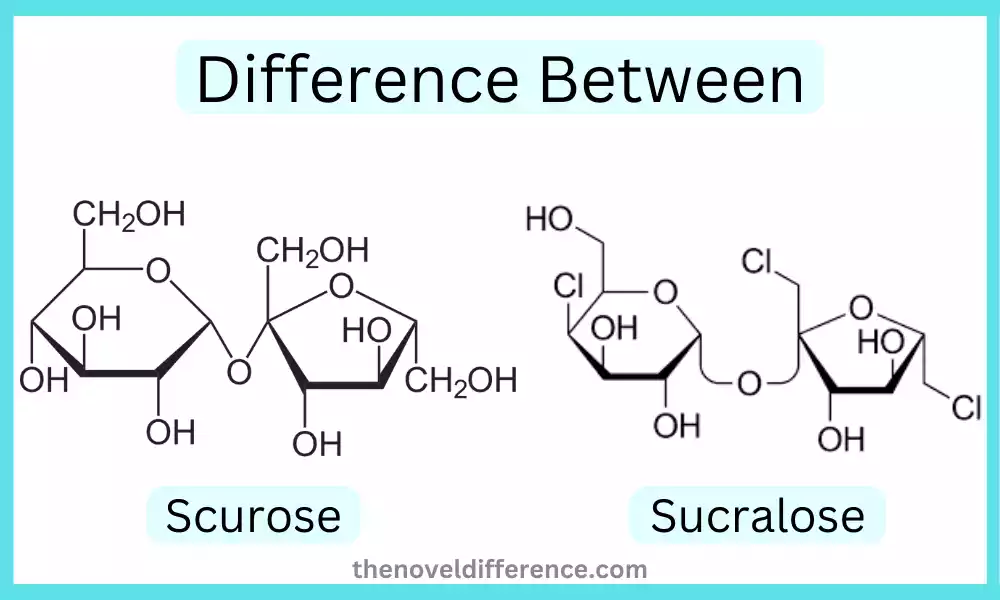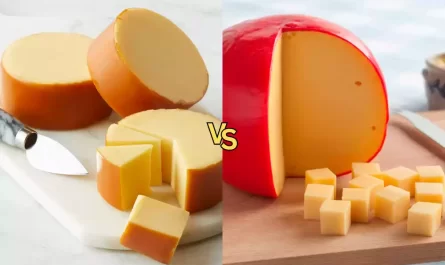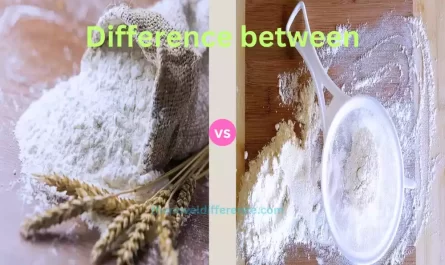Definition of Scurose and Sucralose
Sucrose: Sucrose is an irreducibly sweet natural disaccharide composed of glucose and fructose molecules found naturally in various plant sources like sugarcane or beets; hence its common name table sugar or cane sugar.
Extracted and refined to produce refined granulated forms used throughout food products and beverages as an energy provider with sweetness-giving characteristics; its widespread culinary usage makes Sucrose one of the go-to sweeteners.
Sucralose: Sucralose is an artificial sweetener made chemically through chemical synthesis. This sweetener works by altering the structure of natural sugar (sucrose) by replacing three chlorine atoms for three hydroxyl groups in order to increase sweetness while simultaneously decreasing caloric intake – approximately 600 times sweeter than sucrose and with virtually no calories, sucralose makes an attractive option for individuals trying to cut back their sugar consumption.
Sucralose and sucrose are both sweeteners used to add sweetness to food and beverages, yet their chemical makeup, source, sweetness level, caloric intake, and production methods differ dramatically – this distinction must be acknowledged if individuals with specific dietary needs such as those living with diabetes or looking to lower sugar consumption wish to utilize these sweeteners effectively.
Understanding the Difference between Sucralose and Sucrose
Recognizing and understanding the distinctions between sucrose and sucralose can be crucial for various reasons, including:
1. Health and Nutrition: Sucrose and sucralose each have distinct impacts on the body. Sucrose provides calories that could contribute to weight gain if eaten excessively while raising blood sugar levels – not ideal for people living with diabetes or managing their blood sugar. Meanwhile, sucralose provides sweetness without adding calories or altering blood sugar significantly, thus informing informed choices regarding sugar consumption and overall well-being. Knowing these distinctions allows individuals to make informed choices regarding sugar consumption for maximum long-term benefit and overall wellness.
2. Dietary Considerations: Some individuals may have specific dietary needs or restrictions that require them to avoid certain sweeteners, like sucrose. Individuals following low-cal and low-carbohydrate diets might opt for sucralose instead as an effective sugar replacement; it is important that individuals understand both options so that they can choose which best matches up with their dietary goals and restrictions.
3. Taste and Culinary Applications: Sucrose and sucralose have different tastes; while sucrose provides familiar, traditional sweetness, sucralose offers intense sweetness without additional calories. Being aware of their distinct profiles allows individuals to select the sweetener which best fits their palate or the needs of specific recipes or beverages.
4. Label Reading: Consumers need to understand the difference between sucrose and sucralose so as to more accurately interpret ingredient labels, helping determine whether products contain natural or artificial sweeteners. Furthermore, this gives insight into their nutrition content as well as the potential negative health impacts of such items.
5. Safety Considerations: Some individuals may express reservations regarding artificial sweeteners like sucralose. By understanding the differences between sucrose and sucralose, individuals can investigate research studies, expert opinions and regulatory approvals to make more informed decisions on each sweetener’s potential risks and safety profile.
Understanding the difference between sucrose and sucralose allows individuals to make conscious decisions regarding their sugar consumption, diet preferences and overall wellbeing. Furthermore, understanding this distinction permits informed choices when selecting sweeteners that align with individual requirements such as personal taste preferences or health objectives.
What Is Sucrose?
Mes Sucrose, commonly used as an artificial sweetener in foods and beverages, is an organic disaccharide consisting of two smaller sugar molecules joined together chemically through chemical bonds – in this instance one glucose and one fructose connected by a chemical bond.
Sugarcane, sugar beets and various fruits and vegetables all naturally contain sucrose (an organic form of glucose). Once extracted from its sources it goes through an extraction and refining process before becoming the refined form used by households and food industries alike.
As an all-purpose sweetener, sucrose adds both texture and taste to food and beverages, easily being integrated into recipes thanks to being highly water soluble. Sucrose’s versatility enables its use in various products such as baked goods, desserts, candies, carbonated beverages and sauces – not forgetting baked beans!
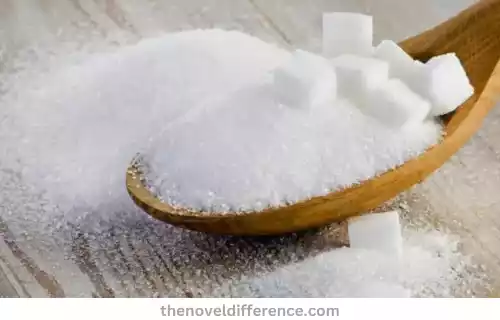
Sucrose provides energy and carbohydrates that nourish our bodies, but in excess, it may contribute to weight gain or have potential negative health implications. Sucrose raises blood sugar levels, so those living with diabetes or seeking to manage their blood sugar should avoid eating it.
Sucrose, a widely recognized sweetener, adds flavor and sweetness to numerous food and beverage products, due to its wide availability and adaptability. Over the course of its widespread culinary applications worldwide, sucrose has quickly become one of the mainstays in culinary practice.
What Is Sucralose?
A sugar substitute, Sucralose is a sweetener made from sucrose, which occurs naturally in sugar. Sucralose production involves chlorination in which three hydroxyl groups in sucrose molecules are replaced by chlorine atoms; this modification enhances its sweetness as well as makes it resistant to metabolic breakdown by our bodies.
Sucralose is approximately 600 times sweeter than sucrose and therefore less is needed to achieve similar levels of sweetness. Yet its intense sweetness has minimal effects on blood sugar levels or caloric intake since its molecules pass harmlessly through our digestive systems without breaking down and being broken down or absorbed, providing virtually zero calories to our diets.
Sucralose’s stability under high temperatures make it ideal for use in baking and cooking applications, including diet sodas, sugar-free desserts, baked goods, powdered drink mixes and powdered drink mixes.
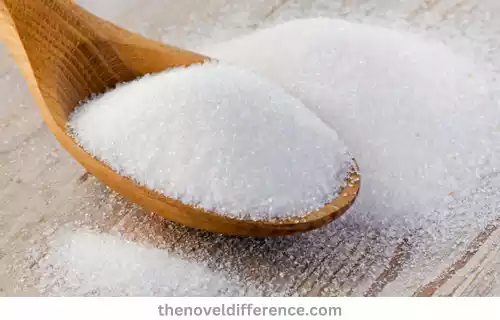
Plus, due to its sweet taste without contributing to tooth decay it has also proven popular as part of oral care products like toothpaste and mouthwashes.
Sucralose has undergone rigorous safety evaluation, receiving approval by various regulatory authorities – such as the Food and Drug Administration in the U.S. and European Food Safety Authority for use. As part of a balanced diet it should be consumed safely by both those without diabetes as well as individuals living with it.
But it should be remembered that different people may react differently to artificial sweeteners like sucralose; consulting healthcare providers or registered dietitians for tailored advice regarding its use according to individual dietary needs and health conditions can offer further help in this matter.
Chemical composition and structure
The chemical composition and structure of sucrose and sucralose differ due to their distinct molecular arrangements:
Sucrose:
Chemical Composition: Sucrose is a disaccharide composed of two monosaccharide units – glucose and fructose. It is formed by a condensation reaction between an α-glucose molecule and a β-fructose molecule, forming a glycosidic bond.
Molecular Structure: Sucrose has a complex molecular structure. It consists of a glucose molecule connected to a fructose molecule through an α,β-1,2-glycosidic bond. This bond connects the α-anomeric carbon of glucose to the β-anomeric carbon of fructose, forming an α,β-glycosidic linkage.
Sucralose:
Chemical Composition: Sucralose is an artificial sweetener derived from sucrose. Through a process of chlorination, three hydroxyl groups in the sucrose molecule are replaced by chlorine atoms. This modification enhances the sweetness and stability of the compound.
Molecular Structure: The chemical modification of sucrose gives rise to the molecular structure of sucralose. Sucralose retains the basic framework of sucrose but with the substitution of chlorine atoms. Specifically, the three hydroxyl groups (located on the C-2, C-4, and C-6 positions) in sucrose are replaced by chlorine atoms, resulting in the formation of a sucralose molecule.
The introduction of chlorine atoms in sucralose imparts greater sweetness to the compound while making it resistant to metabolic breakdown by the body.
Sucrose is a naturally occurring disaccharide composed of glucose and fructose, while sucralose is an artificial sweetener derived from sucrose through a chemical modification process.
Sucrose has a glycosidic bond connecting glucose and fructose, while sucralose retains the basic molecular structure of sucrose but with the substitution of chlorine atoms.
The Differences between Sucrose and Sucralose
Between sucrose and sucralose, there are some key differences:
- Chemical composition: Sucrose, a naturally occurring disaccharide made up of glucose and fructose molecule is a disaccharide. Sucralose, on the other hand, is an artificial sweetener that’s derived from sucrose by a chemical process in which three hydroxyl groups are replaced with chlorine atoms.
- Sources and Production: Sugar is derived from plant sources, such as sugarcane or sugar beets. Granulated sugar is produced by extraction and refinement processes. Sucralose, on the other hand is synthesized in a lab by chemically altering sucrose.
- Sweetness level: Sucrose has a moderate sweetness while sucralose provides a much sweeter sweetness. Sucralose has a sweetness level 600 times greater than sucrose. This means that a lower amount of sucralose will be needed to reach the same level.
- Caloric content: Sucrose contains about 4 calories per 1 gram. Sucralose, on the other hand, is a sweetener that has virtually no calories. It is not metabolized and passes through the digestive tract without adding calories to your diet.
- Taste profile: Sucrose has a familiar, rounded sweetness. Sucralose is a sweeter alternative. Sucralose is described by some as having an intense sweetness without the lingering aftertaste of other artificial sweeteners.
- Blood Sugar Impact and Metabolism: Sugar is metabolized in the body, and it can increase blood sugar levels. This makes it unsuitable to individuals with diabetes and those who are trying to control their blood sugar. Sucralose does not affect blood sugar levels and is not metabolized by the body. It’s a good sugar substitute for people with diabetes or who follow a low-carbohydrate diet.
- Applications Sucrose can be found in many foods and drinks, such as baked goods, desserts and beverages. Sucralose can be used to replace sugar in products that are sugar-free, reduced-sugar, or low-calorie. Sucralose is stable at high temperatures, making it ideal for baking and cooking.
- Health Considerations Although both sucrose (sucralose) and sucrose are considered safe by regulatory agencies for consumption, they have distinct health implications. Sucralose can cause weight gain and other negative health effects if consumed in excess. Sucralose is a nonnutritive sweetener that provides sweetness without adding calories. Sucralose, or any artificial sweetener, may not be suitable for some people due to their sensitivities.
Understanding the key differences between sucralose and sucrose can help individuals make informed choices about their sugar intake and dietary goals.
Sucrose vs Sucralose in Tabular Form
Sure! Here’s a tabular comparison of sucrose and sucralose:
| Sucrose | Sucralose |
|---|---|
| Natural disaccharide | Artificial sweetener |
| Composed of glucose and | Derived from sucrose |
| fructose molecules | through chemical modification |
| Found in sugarcane, | Synthetically produced |
| sugar beets, and fruits | in a laboratory |
| Moderate sweetness | Much sweeter, approximately 600 times sweeter than sucrose |
| Provides calories (about 4 | Virtually calorie-free |
| calories per gram) | |
| Metabolized by the body, | Not metabolized by the |
| can raise blood sugar | the body does not have a |
| levels | significant impact on blood sugar levels |
| Familiar rounded sweetness | Intense sweetness with |
| no lingering aftertaste | |
| Wide range of applications | Commonly used as a |
| in food and beverages | sugar substitute in |
| sugar-free or reduced-sugar products | |
| Suitable for most people | Suitable for individuals |
| with diabetes or those | |
| seeking low-carbohydrate | |
| options |
This table concisely overviews the main differences between sucrose and sucralose, highlighting their composition, source, sweetness level, caloric content, metabolism, taste profile, applications, and suitability for specific dietary needs.
What are the similarities Between Sucrose and Sucralose?
While there are several differences between sucrose and sucralose, they do share a few similarities:
- Sweetness: Both sucrose and sucralose are sweet substances used as sweeteners. While sucrose provides a moderate level of sweetness, sucralose is significantly sweeter, being approximately 600 times sweeter than sucrose.
- Solubility: Both sucrose and sucralose are highly soluble in water. This property makes them easy to incorporate into various food and beverage preparations.
- Stability: Both sucrose and sucralose exhibit stability under normal cooking and baking conditions. Sucrose retains its sweetness even when exposed to heat, making it suitable for use in a wide range of recipes. Similarly, sucralose maintains its sweetness under high temperatures, making it useful for sugar-free baked goods and other heated applications.
- Sweetening Power: Sucrose and sucralose enhance the taste and sweetness of foods and beverages. However, due to the higher sweetness level of sucralose, smaller amounts are needed to achieve the desired level of sweetness compared to sucrose.
It is worth noting that while sucrose and sucralose share some similarities, they also have significant differences in terms of source, caloric content, metabolism, and health implications.
Understanding these distinctions is important for individuals who are considering using these sweeteners or looking for suitable alternatives based on their specific dietary needs and preferences.
Applications and Usage
Applications and usage of sucrose and sucralose differ due to their unique properties. Here’s a breakdown of their respective applications:
Sucrose:
- Sweetener: Sucrose is widely used as a sweetener in a vast range of food and beverage products, including baked goods, desserts, confectioneries, beverages, and sauces. It provides sweetness and flavor to these items, enhancing their taste.
- Food Preservation: Sucrose is used in the preservation of certain fruits, such as jams, jellies, and fruit preserves, as it acts as a natural preservative and helps extend its shelf life.
- Texture and Structure: Sucrose plays a crucial role in baking by providing bulk, structure, and tenderness to baked goods. It contributes to the texture and appearance of items like cakes, cookies, and pastries.
Sucralose:
- Sugar Substitute: Sucralose is commonly used as a sugar substitute in a variety of sugar-free or reduced-sugar products. It provides sweetness without adding significant calories, making it suitable for individuals looking to reduce their sugar intake or manage their calorie consumption.
- Beverages: Sucralose is frequently used in the production of diet sodas, powdered drink mixes, and low-calorie beverages. It imparts sweetness to these products without the added calories of sucrose.
- Sugar-Free Desserts: Sucralose is employed in the production of sugar-free desserts such as ice creams, puddings, and gelatins. It allows for sweet treats with reduced or no added sugar content.
- Pharmaceutical and Oral Care: Sucralose is used in the manufacturing of pharmaceuticals and oral care products like toothpaste and mouthwash. It can help mask bitter flavors and improve the taste of medications and oral care formulations.
It’s important to note that the suitability and recommended usage of sucrose and sucralose can vary based on individual dietary needs, health conditions, and preferences.
It’s always advisable to refer to product labels, consult healthcare professionals, or follow specific dietary guidelines when incorporating these sweeteners into one’s diet.
Consumer Awareness and Labeling
Consumer awareness and accurate labeling play a crucial role in helping individuals make informed choices about the use of sucrose and sucralose in their diet.
Here’s a discussion on consumer awareness and labeling related to these sweeteners:
- Ingredient Labels: Food and beverage products are typically required to list the ingredients used, including sweeteners like sucrose and sucralose. By reading ingredient labels, consumers can identify the presence and relative quantity of these sweeteners in the product. This allows individuals to make conscious decisions based on their dietary preferences and needs.
- Nutritional Information: In many jurisdictions, food products are also required to provide nutritional information on the packaging. This information includes the total carbohydrate content, which may indicate the presence of sugar (including sucrose) and the caloric value. For products that use sucralose, the packaging may indicate that it is a non-nutritive sweetener with negligible calories.
- Sugar-Free or Reduced-Sugar Claims: Food products labeled “sugar-free” or “reduced sugar” typically use sucralose as their sweetening agent. These labels can help individuals seeking to limit their sugar intake or manage their blood sugar levels to identify suitable options.
- Allergen and Sensitivity Considerations: Individuals with specific allergies or sensitivities should be aware of the presence of sucrose or sucralose in food products. Sucrose, being derived from sugarcane or sugar beets, may pose risks for those with related allergies. On the other hand, sucralose is generally considered safe for consumption, but individuals with specific sensitivities or medical conditions should consult healthcare professionals if unsure.
- Educating Consumers: Health organizations, government agencies, and nutrition experts play a vital role in educating consumers about different sweeteners, including sucrose and sucralose. Informative resources, guidelines, and campaigns can help individuals understand the potential effects, benefits, and risks associated with these sweeteners. Consumer education can also promote healthier and more informed choices in terms of sugar consumption.
Consumers must be informed about the sweeteners they use in their food or beverages, their nutritional effects, and their own dietary needs and restrictions. By understanding product labels and available data, individuals can make smart choices to support their health and wellness objectives.
Conclusion
Understanding the differences between sucrose and sucralose is integral in making informed choices regarding sugar consumption and diet preferences.
Sucrose, derived naturally from plants, provides moderate sweetness but adds calories; on the other hand, sucralose–an artificial sweetener made of sucrose–provides intense sweetness with zero additional calorie consumption.
Sucrose, widely employed in food and beverage products to enhance taste, texture, and preservation, is widely utilized as a sweetener. Unfortunately, due to being processed by the body, it can have negative impacts on blood sugar levels making it less suitable for individuals living with or managing their diabetes effectively.
As an alternative, sucralose (an artificial sweetener with no nutritional benefits) has emerged as a suitable sugar alternative that doesn’t alter glucose levels significantly making it suitable for low-carb alternatives and those trying to manage blood sugar more effectively than sucrose does.

